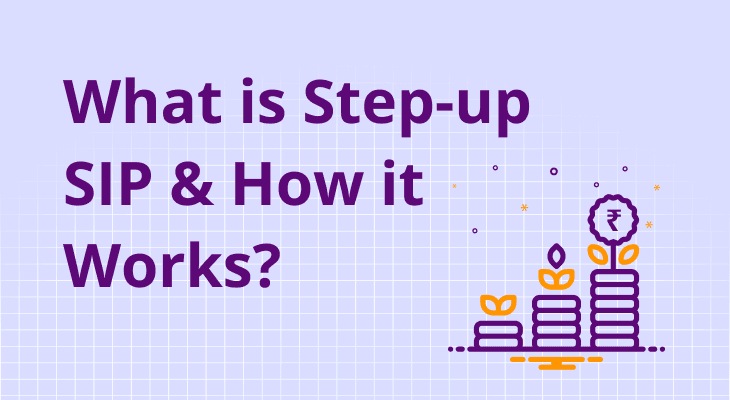
Table of content
What is Step-up SIP & How it Works?
Investing effectively needs not just discipline, but also the ability to react to changing financial situations. This is where Step-up Systematic Investment Plans (SIPs) come in, providing a strategic approach to mutual fund investments that can be modified to your changing income levels and financial objectives. In recent years, Systematic Investment Plans (SIPs) have grown in popularity among Indian investors, encouraging a disciplined approach to mutual fund investment. Individuals can use SIPs to invest a set amount on a regular basis, often monthly, taking advantage of rupee-cost averaging and limiting the effects of market volatility.
Traditional SIPs, on the other hand, presume a fixed investment amount during their tenure, which may not necessarily reflect the reality of increasing earnings over time. Step-up SIPs provide a solution, allowing investors to gradually raise their SIP payments at specified times while effectively adapting to their financial progress. Let us delve into the intricate details of Step-up SIPs, how they function, the benefits they offer, and why they may be the best option for you.
What is Step up SIP?
A Step-up SIP, sometimes called a Top-up SIP, adds a dynamic aspect to standard SIPs by allowing participants to gradually raise their contribution amount over time. Unlike fixed SIPs, step-up SIPs allow for monthly increases in either a fixed sum or a percentage of the initial investment. This flexibility guarantees that your investments stay up with inflation and rising incomes, boosting wealth creation potential.
How does Step up SIP investment work?
Step-up SIPs work on the idea of gradual additions, and investors have two basic options for increasing their SIP contributions:
Percentage Basis:
Investors can choose to raise their SIP amount yearly by a predetermined percentage of the initial deposit. Starting with a SIP of ₹ 5,000 per month and raising it by 10% yearly yields ₹ 5,500 in the second year, ₹ 6,050 in the third year, and so on.
Amount Basis:
Investors can also opt to raise their SIP amount by a specific rupee amount each year. For example, starting with ₹ 5,000 each month and growing by ₹ 1,000 yearly would result in ₹ 6,000 in the second year, ₹ 7,000 in the third year, etc.
Individual financial goals and income growth predictions influence whatever strategy is chosen, resulting in a customised approach to long-term wealth generation.
Advantages of Step-up SIP
The Step-up SIPs have several advantages, inviting investors looking for a structured yet flexible investment strategy:
Adaptability:
Step-up SIPs adapt to shifting financial conditions by allowing investors to match their contributions to rising income levels.
Compounding Benefits:
By gradually increasing investments over time, investors may use the power of compounding, whereby returns on investments produce further returns, hence improving overall wealth accumulation.
Rupee-cost Averaging:
Step-up SIPs, like standard SIPs, benefit from rupee-cost averaging, which smoothes out the impact of market swings by distributing investments across different market circumstances.
Financial Discipline:
Automating gradual increases in SIP amounts promotes financial discipline by encouraging long-term savings and investment behaviour.
Difference between Regular SIP & Step up SIP
While both Regular SIPs and Step-up SIPs have the aim of disciplined investment in mutual funds, their approaches differ greatly.
Regular SIP:
Maintains a consistent investment amount over time, making it ideal for steady income situations and long-term financial goals.
Step-up SIP:
Allows for periodic increases in investment amounts, which is suitable for individuals experiencing income growth or looking to capitalise on market opportunities by making larger contributions over time.
Start & Stop Criteria for Step-Up SIP
Initiating and ending a Step-up SIP requires strategic decisions based on individual financial goals and circumstances:
Start Criteria:
Begin a Step-up SIP early in your career to reap the benefits of compounding. Begin when you have a consistent income and defined financial goals that match with long-term wealth growth.
Stop Criteria:
Consider pausing or discontinuing a Step-up SIP when financial goals are met, income becomes inconsistent, or market circumstances no longer support continuous investing. Regular review and modification are essential for improving SIP performance.
Things to Remember Before Starting a Step-Up SIP Investment
Before starting a Step-up SIP, consider the following factors:
Financial Assessment:
Determine appropriate SIP increments and intervals by assessing your present financial situation, income growth predictions, and long-term financial goals.
Fund Selection:
Select mutual funds that match your risk tolerance, investment horizon, and financial goals. Diversify your investments to reduce risk and boost earnings.
Monitoring and Adjustment:
Regularly review SIP performance and alter contributions as needed to reflect changing financial situations and market conditions.
Reasons to Top up your Step up SIP
Top-up your Step-up SIP to leverage additional benefits:
Capitalising on Market Opportunities:
Increase your investments during market downturns to take advantage of lower asset prices and potential future profits.
Enhancing the Compounding Effect:
Additional investments increase the power of compounding, boosting wealth creation over time.
Aligning with Income Growth:
Use yearly bonuses or salary increases to boost SIPs, ensuring that investments stay up with rising income levels and inflation.
Adapting to Evolving Goals:
Adjust SIP contributions to reflect new financial objectives or changing life circumstances, ensuring investment relevance and effectiveness.
Who should invest in Step up SIP
Step-up SIPs are particularly suited for:
Goal-oriented Investors:
Individuals with specific financial goals, such as retirement planning or supporting higher education, benefit from adjustable SIP increments that are linked to their changing objectives.
Young Professionals:
Investors with rising income levels can begin with small contributions and progressively raise their SIP amounts over time, maximising long-term wealth growth.
Variable Income Earners:
Freelancers, consultants, and individuals with varying earnings benefit from altering SIP contributions to account for cash flow variations and income variability.
Conclusion
Step-up SIPs are an excellent way to invest in mutual funds, providing flexibility, discipline, and the possibility for quick wealth building. By gradually raising SIP payments over time, investors may take advantage of compounding while responding to changing financial conditions and goals. Whether you are a young professional starting on your investment adventure or a seasoned investor saving for retirement, step-up SIPs offer an adaptable strategy for achieving long-term financial success.
FAQ
When can you open a Step-Up SIP?
Step-up SIPs can be started at any moment when investors anticipate higher revenues or want to better match their savings with their growing financial capabilities. Starting early allows you to take advantage of long-term compounding.
Can you start small with a Step-Up SIP?
Yes, one advantage of Step-up SIPs is that you may start with a little investment and progressively grow it over time. This flexibility enables investors to begin with what they can afford and then change as their income increases.
Can I cancel my Step-up SIP before it is completed?
Yes, investors can discontinue their Step-up SIP at any time. This may be done when financial objectives are accomplished, priorities shift, or funds need to be reallocated to other investments or expenses.
What are the advantages of using a Step-Up SIP over a standard SIP?
Step-up SIPs have the benefit of adjusting to rising income levels over time, ensuring that savings stay up with inflation and financial objectives. Unlike conventional SIPs, which have a set investment amount, step-up SIPs allow for gradual increments.
How can a Step-up SIP help with wealth creation?
Step-up SIPs effectively utilise compounding by allowing individuals to gradually raise their contribution amounts. This gradual increment strategy not only generates a larger investment portfolio over time but also helps reduce the effects of market volatility.
What aspects should I examine before launching a Step-up SIP?
Before establishing a Step-up SIP, think about your long-term financial goals, expected income growth, and risk tolerance. It is important to select mutual funds that are consistent with your objectives for investing and to assess your approach regularly to make any necessary modifications.
Is there a maximum amount that I may increase my SIP amount annually in a Step-up SIP?
The maximum yearly rise in SIP amount varies according to the mutual fund's rules and your financial ability. Typically, investors select a percentage-based or set rupee amount increase that meets their budget and aspirations.
Can I go from a standard SIP to a Step-Up SIP?
Yes, investors may transition from a normal SIP to a Step-up SIP if they expect their salaries to rise in the future or want to gradually raise their savings rate. This change enables more flexible and adaptable investment techniques.
How often can I change my SIP amount in a Step-Up SIP?
Step-up SIPs typically require investors to modify their SIP amount once a year. This modification can be based on personal financial growth, ensuring that investments remain consistent with changing income levels and financial goals.
What should I do if I don't increase my SIP amount in a given year of a Step-up SIP?
Missing an increase in the SIP amount in a Step-up SIP does not usually result in fines. However, it is recommended that you catch up on missed increments in later years to keep pace with your chosen investment path and financial goals.


